Statistics for Management: Consumer Price Index Activity Report
VerifiedAdded on 2020/12/09
|20
|4443
|300
Report
AI Summary
This report presents a comprehensive statistical analysis of UK economic data, focusing on consumer price index (CPI), retail price index (RPI), and inflation rates from 2007 to 2017. It includes a comparative analysis of CPI and CPIH, along with calculations of annual inflation. The report also investigates hourly pay rates in different UK regions, using ogive charts to identify median earnings and quartiles. Descriptive statistics, including mean and standard deviation, are calculated for hourly earnings. Furthermore, the report conducts paired t-tests to analyze mean length time of using new and old system and presents 99% confidence intervals. The data is presented in tables and charts for easy interpretation, reflecting on the differences between the indices and the importance of inflation data. The report concludes with a reflection on the trends and implications of the analyzed data.

STATISTICS FOR
MANAGEMENT
MANAGEMENT
Paraphrase This Document
Need a fresh take? Get an instant paraphrase of this document with our AI Paraphraser

TABLE OF CONTENTS
INTRODUCTION...........................................................................................................................1
ACTIVITY 1....................................................................................................................................1
A. Using Office of national statistics for data relate to prices index.........................................1
Consumer price index (CPI and CPIH).......................................................................................1
B. Producing appropriate tables and charts to reflect changes over 2007 to 2017.....................3
C. Differences between above stated indices..............................................................................4
D. Application of CPI for calculating annual inflation...............................................................5
E. Importance of information related to rate of inflation............................................................6
ACTIVITY 2....................................................................................................................................6
Hourly pay rates in UK region....................................................................................................6
A.1 Ogive chart for identifying median hourly earnings with quartiles.....................................6
A.2 Finding standard deviation and mean for hourly earnings...................................................8
B. Drafting comparison in earnings of London and Manchester region.....................................9
ACTIVITY 3..................................................................................................................................10
2.a Carrying paired t test at 5% significance level for identifying mean length.......................10
2.b Present usual conditions with context of paired t test.........................................................13
2.c Presenting 99% confidence interval....................................................................................13
ACTIVITY 4..................................................................................................................................16
A. Reflecting charts of CPI, RPI and CPIH over year 2007 to 2017........................................16
B. Draft Ogive chart for cumulative % staff vs hourly earnings..............................................16
CONCLUSION..............................................................................................................................17
REFERENCES..............................................................................................................................18
INTRODUCTION...........................................................................................................................1
ACTIVITY 1....................................................................................................................................1
A. Using Office of national statistics for data relate to prices index.........................................1
Consumer price index (CPI and CPIH).......................................................................................1
B. Producing appropriate tables and charts to reflect changes over 2007 to 2017.....................3
C. Differences between above stated indices..............................................................................4
D. Application of CPI for calculating annual inflation...............................................................5
E. Importance of information related to rate of inflation............................................................6
ACTIVITY 2....................................................................................................................................6
Hourly pay rates in UK region....................................................................................................6
A.1 Ogive chart for identifying median hourly earnings with quartiles.....................................6
A.2 Finding standard deviation and mean for hourly earnings...................................................8
B. Drafting comparison in earnings of London and Manchester region.....................................9
ACTIVITY 3..................................................................................................................................10
2.a Carrying paired t test at 5% significance level for identifying mean length.......................10
2.b Present usual conditions with context of paired t test.........................................................13
2.c Presenting 99% confidence interval....................................................................................13
ACTIVITY 4..................................................................................................................................16
A. Reflecting charts of CPI, RPI and CPIH over year 2007 to 2017........................................16
B. Draft Ogive chart for cumulative % staff vs hourly earnings..............................................16
CONCLUSION..............................................................................................................................17
REFERENCES..............................................................................................................................18
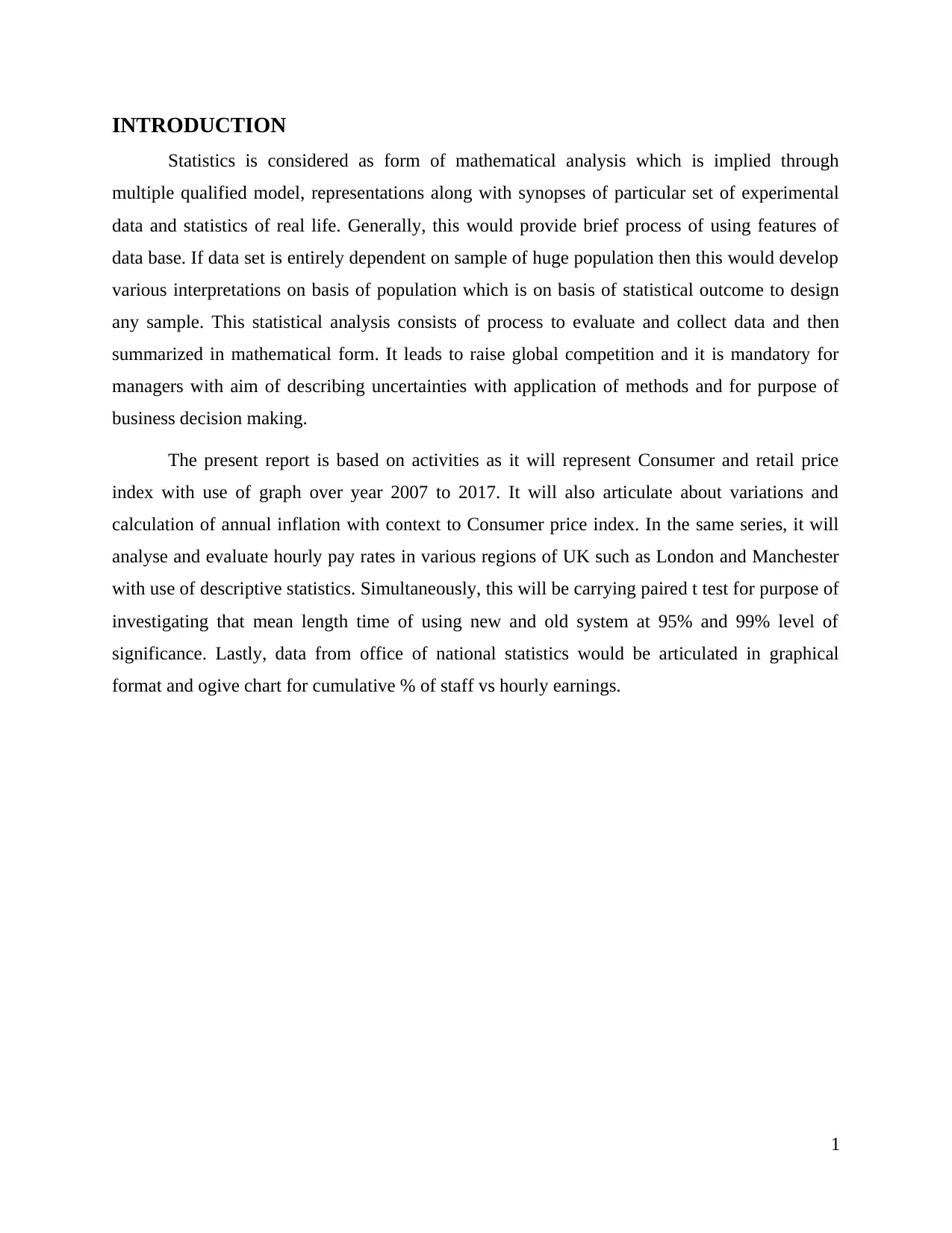
INTRODUCTION
Statistics is considered as form of mathematical analysis which is implied through
multiple qualified model, representations along with synopses of particular set of experimental
data and statistics of real life. Generally, this would provide brief process of using features of
data base. If data set is entirely dependent on sample of huge population then this would develop
various interpretations on basis of population which is on basis of statistical outcome to design
any sample. This statistical analysis consists of process to evaluate and collect data and then
summarized in mathematical form. It leads to raise global competition and it is mandatory for
managers with aim of describing uncertainties with application of methods and for purpose of
business decision making.
The present report is based on activities as it will represent Consumer and retail price
index with use of graph over year 2007 to 2017. It will also articulate about variations and
calculation of annual inflation with context to Consumer price index. In the same series, it will
analyse and evaluate hourly pay rates in various regions of UK such as London and Manchester
with use of descriptive statistics. Simultaneously, this will be carrying paired t test for purpose of
investigating that mean length time of using new and old system at 95% and 99% level of
significance. Lastly, data from office of national statistics would be articulated in graphical
format and ogive chart for cumulative % of staff vs hourly earnings.
1
Statistics is considered as form of mathematical analysis which is implied through
multiple qualified model, representations along with synopses of particular set of experimental
data and statistics of real life. Generally, this would provide brief process of using features of
data base. If data set is entirely dependent on sample of huge population then this would develop
various interpretations on basis of population which is on basis of statistical outcome to design
any sample. This statistical analysis consists of process to evaluate and collect data and then
summarized in mathematical form. It leads to raise global competition and it is mandatory for
managers with aim of describing uncertainties with application of methods and for purpose of
business decision making.
The present report is based on activities as it will represent Consumer and retail price
index with use of graph over year 2007 to 2017. It will also articulate about variations and
calculation of annual inflation with context to Consumer price index. In the same series, it will
analyse and evaluate hourly pay rates in various regions of UK such as London and Manchester
with use of descriptive statistics. Simultaneously, this will be carrying paired t test for purpose of
investigating that mean length time of using new and old system at 95% and 99% level of
significance. Lastly, data from office of national statistics would be articulated in graphical
format and ogive chart for cumulative % of staff vs hourly earnings.
1
⊘ This is a preview!⊘
Do you want full access?
Subscribe today to unlock all pages.

Trusted by 1+ million students worldwide
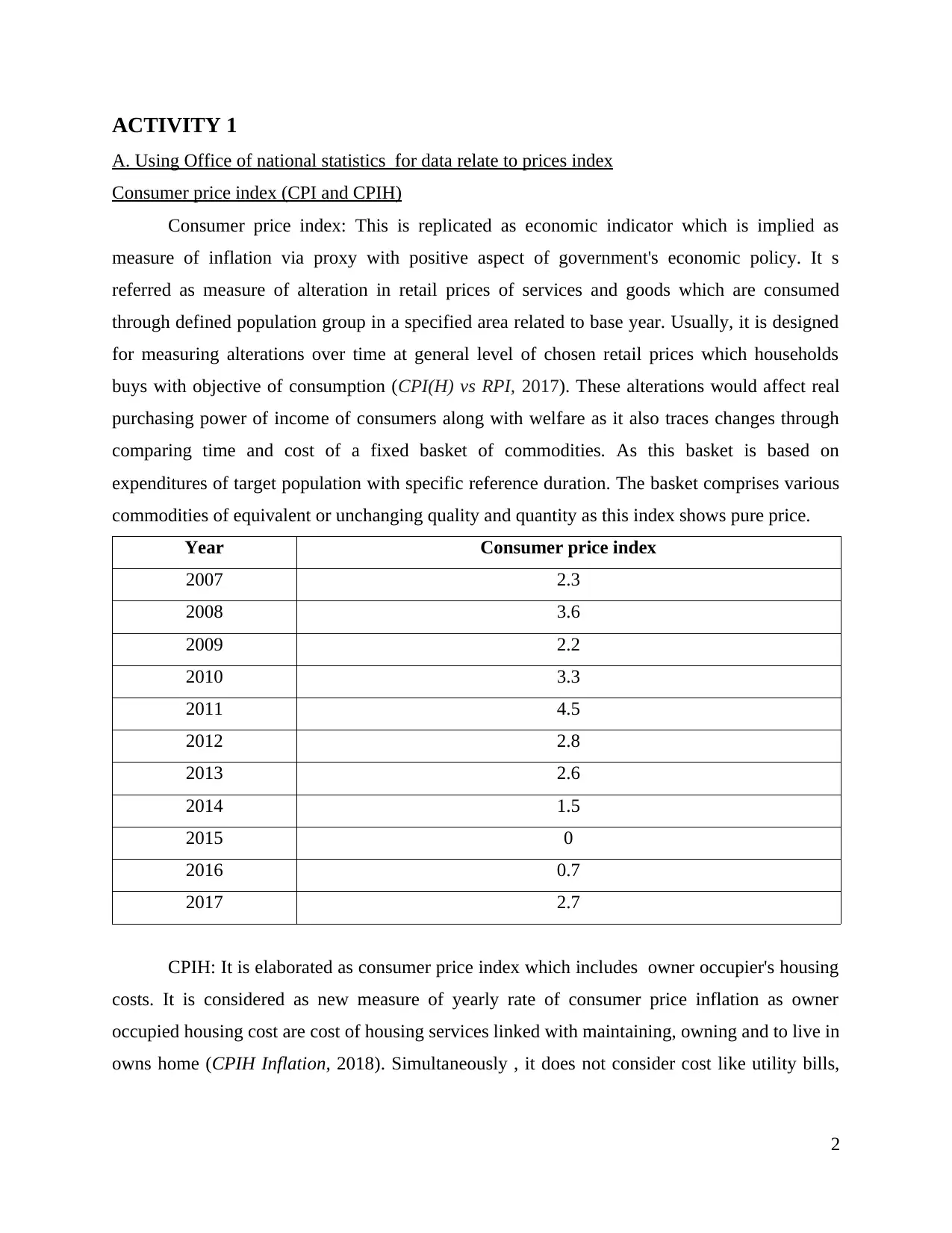
ACTIVITY 1
A. Using Office of national statistics for data relate to prices index
Consumer price index (CPI and CPIH)
Consumer price index: This is replicated as economic indicator which is implied as
measure of inflation via proxy with positive aspect of government's economic policy. It s
referred as measure of alteration in retail prices of services and goods which are consumed
through defined population group in a specified area related to base year. Usually, it is designed
for measuring alterations over time at general level of chosen retail prices which households
buys with objective of consumption (CPI(H) vs RPI, 2017). These alterations would affect real
purchasing power of income of consumers along with welfare as it also traces changes through
comparing time and cost of a fixed basket of commodities. As this basket is based on
expenditures of target population with specific reference duration. The basket comprises various
commodities of equivalent or unchanging quality and quantity as this index shows pure price.
Year Consumer price index
2007 2.3
2008 3.6
2009 2.2
2010 3.3
2011 4.5
2012 2.8
2013 2.6
2014 1.5
2015 0
2016 0.7
2017 2.7
CPIH: It is elaborated as consumer price index which includes owner occupier's housing
costs. It is considered as new measure of yearly rate of consumer price inflation as owner
occupied housing cost are cost of housing services linked with maintaining, owning and to live in
owns home (CPIH Inflation, 2018). Simultaneously , it does not consider cost like utility bills,
2
A. Using Office of national statistics for data relate to prices index
Consumer price index (CPI and CPIH)
Consumer price index: This is replicated as economic indicator which is implied as
measure of inflation via proxy with positive aspect of government's economic policy. It s
referred as measure of alteration in retail prices of services and goods which are consumed
through defined population group in a specified area related to base year. Usually, it is designed
for measuring alterations over time at general level of chosen retail prices which households
buys with objective of consumption (CPI(H) vs RPI, 2017). These alterations would affect real
purchasing power of income of consumers along with welfare as it also traces changes through
comparing time and cost of a fixed basket of commodities. As this basket is based on
expenditures of target population with specific reference duration. The basket comprises various
commodities of equivalent or unchanging quality and quantity as this index shows pure price.
Year Consumer price index
2007 2.3
2008 3.6
2009 2.2
2010 3.3
2011 4.5
2012 2.8
2013 2.6
2014 1.5
2015 0
2016 0.7
2017 2.7
CPIH: It is elaborated as consumer price index which includes owner occupier's housing
costs. It is considered as new measure of yearly rate of consumer price inflation as owner
occupied housing cost are cost of housing services linked with maintaining, owning and to live in
owns home (CPIH Inflation, 2018). Simultaneously , it does not consider cost like utility bills,
2
Paraphrase This Document
Need a fresh take? Get an instant paraphrase of this document with our AI Paraphraser
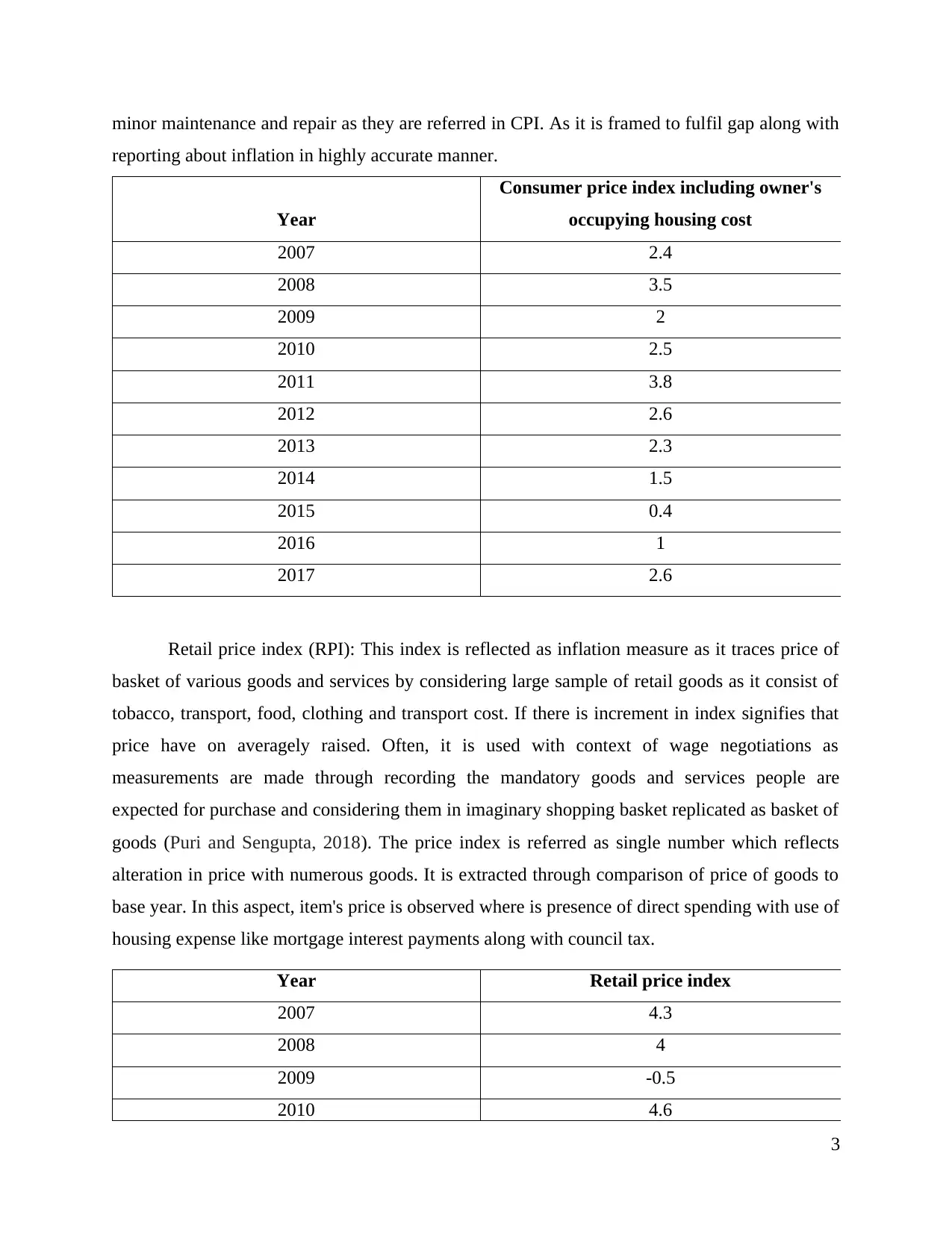
minor maintenance and repair as they are referred in CPI. As it is framed to fulfil gap along with
reporting about inflation in highly accurate manner.
Year
Consumer price index including owner's
occupying housing cost
2007 2.4
2008 3.5
2009 2
2010 2.5
2011 3.8
2012 2.6
2013 2.3
2014 1.5
2015 0.4
2016 1
2017 2.6
Retail price index (RPI): This index is reflected as inflation measure as it traces price of
basket of various goods and services by considering large sample of retail goods as it consist of
tobacco, transport, food, clothing and transport cost. If there is increment in index signifies that
price have on averagely raised. Often, it is used with context of wage negotiations as
measurements are made through recording the mandatory goods and services people are
expected for purchase and considering them in imaginary shopping basket replicated as basket of
goods (Puri and Sengupta, 2018). The price index is referred as single number which reflects
alteration in price with numerous goods. It is extracted through comparison of price of goods to
base year. In this aspect, item's price is observed where is presence of direct spending with use of
housing expense like mortgage interest payments along with council tax.
Year Retail price index
2007 4.3
2008 4
2009 -0.5
2010 4.6
3
reporting about inflation in highly accurate manner.
Year
Consumer price index including owner's
occupying housing cost
2007 2.4
2008 3.5
2009 2
2010 2.5
2011 3.8
2012 2.6
2013 2.3
2014 1.5
2015 0.4
2016 1
2017 2.6
Retail price index (RPI): This index is reflected as inflation measure as it traces price of
basket of various goods and services by considering large sample of retail goods as it consist of
tobacco, transport, food, clothing and transport cost. If there is increment in index signifies that
price have on averagely raised. Often, it is used with context of wage negotiations as
measurements are made through recording the mandatory goods and services people are
expected for purchase and considering them in imaginary shopping basket replicated as basket of
goods (Puri and Sengupta, 2018). The price index is referred as single number which reflects
alteration in price with numerous goods. It is extracted through comparison of price of goods to
base year. In this aspect, item's price is observed where is presence of direct spending with use of
housing expense like mortgage interest payments along with council tax.
Year Retail price index
2007 4.3
2008 4
2009 -0.5
2010 4.6
3

2011 5.2
2012 3.2
2013 3
2014 2.4
2015 1
2016 1.8
2017 3.6
B. Producing appropriate tables and charts to reflect changes over 2007 to 2017.
Interpretation: The graphical representation is of both indices which are CPI, CPIH and
RPI of United Kingdom. It is clearly viewed that each index has multiple fluctuations so while
referring to retail price index as it was highest in year 2007 which started decreasing but in 2009,
it reflects drastic change as negative 0.5. Beside from this, in year 2010 it moved to positive
aspect as 4.6. Simultaneously, in 2011 this had a fall on annual basis and this trend continued till
year 2015 but in year 2016 and 2017, it increased to 1.8 and 3.6 significantly. Moreover,. With
consideration of CPI and CPIH as it was increasing in multiple aspects but in 2015, CPI was 0
and CPIH was 0.4 which shows positive points related to economy. On the contrary, in year
2011 it has high inflation so it is observed that CPI and CPIH had not faced major change from
2007 to 2017 but minor increment by 0.5 and 0.2 respectively. Furthermore, it is observed that
4
2012 3.2
2013 3
2014 2.4
2015 1
2016 1.8
2017 3.6
B. Producing appropriate tables and charts to reflect changes over 2007 to 2017.
Interpretation: The graphical representation is of both indices which are CPI, CPIH and
RPI of United Kingdom. It is clearly viewed that each index has multiple fluctuations so while
referring to retail price index as it was highest in year 2007 which started decreasing but in 2009,
it reflects drastic change as negative 0.5. Beside from this, in year 2010 it moved to positive
aspect as 4.6. Simultaneously, in 2011 this had a fall on annual basis and this trend continued till
year 2015 but in year 2016 and 2017, it increased to 1.8 and 3.6 significantly. Moreover,. With
consideration of CPI and CPIH as it was increasing in multiple aspects but in 2015, CPI was 0
and CPIH was 0.4 which shows positive points related to economy. On the contrary, in year
2011 it has high inflation so it is observed that CPI and CPIH had not faced major change from
2007 to 2017 but minor increment by 0.5 and 0.2 respectively. Furthermore, it is observed that
4
⊘ This is a preview!⊘
Do you want full access?
Subscribe today to unlock all pages.

Trusted by 1+ million students worldwide
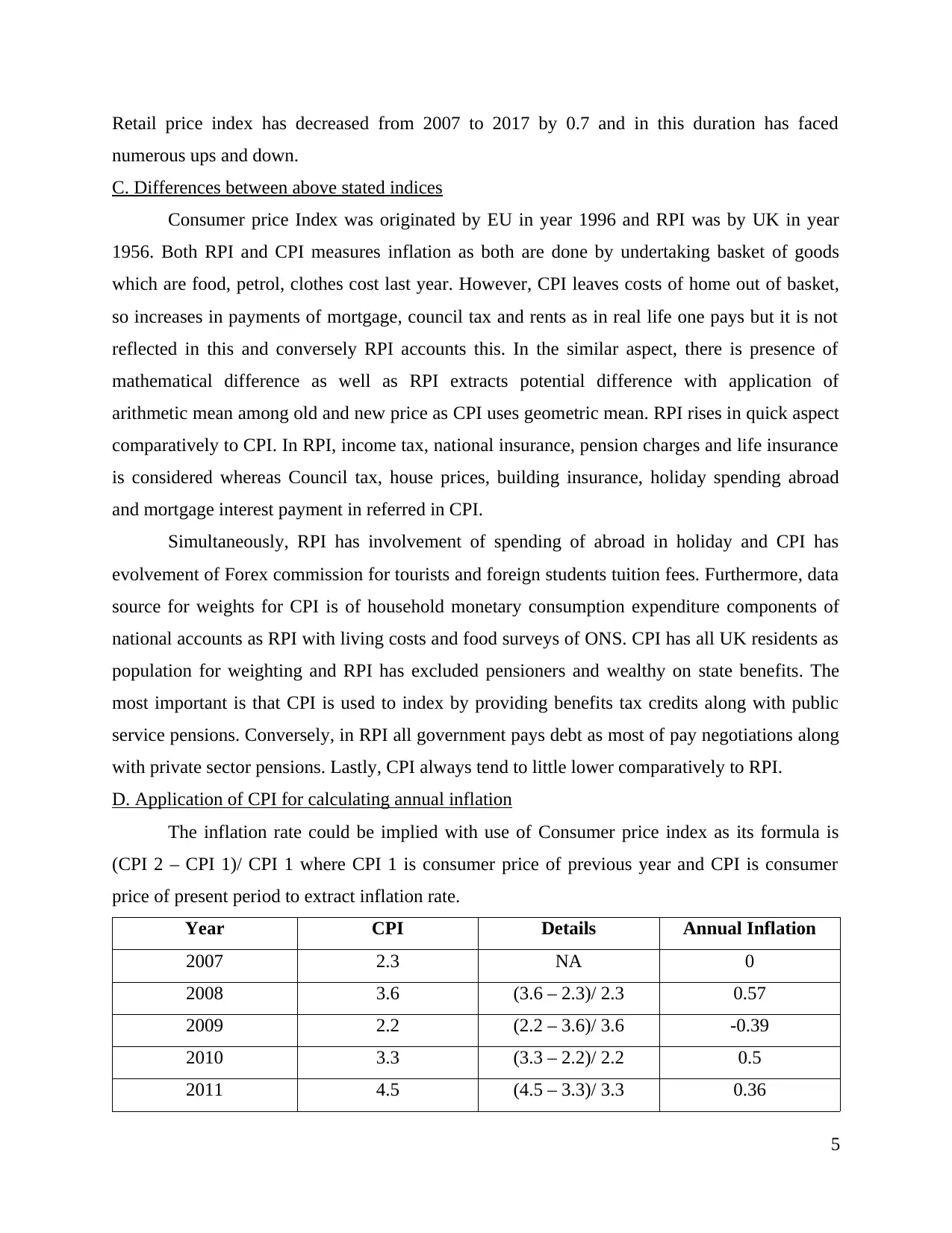
Retail price index has decreased from 2007 to 2017 by 0.7 and in this duration has faced
numerous ups and down.
C. Differences between above stated indices
Consumer price Index was originated by EU in year 1996 and RPI was by UK in year
1956. Both RPI and CPI measures inflation as both are done by undertaking basket of goods
which are food, petrol, clothes cost last year. However, CPI leaves costs of home out of basket,
so increases in payments of mortgage, council tax and rents as in real life one pays but it is not
reflected in this and conversely RPI accounts this. In the similar aspect, there is presence of
mathematical difference as well as RPI extracts potential difference with application of
arithmetic mean among old and new price as CPI uses geometric mean. RPI rises in quick aspect
comparatively to CPI. In RPI, income tax, national insurance, pension charges and life insurance
is considered whereas Council tax, house prices, building insurance, holiday spending abroad
and mortgage interest payment in referred in CPI.
Simultaneously, RPI has involvement of spending of abroad in holiday and CPI has
evolvement of Forex commission for tourists and foreign students tuition fees. Furthermore, data
source for weights for CPI is of household monetary consumption expenditure components of
national accounts as RPI with living costs and food surveys of ONS. CPI has all UK residents as
population for weighting and RPI has excluded pensioners and wealthy on state benefits. The
most important is that CPI is used to index by providing benefits tax credits along with public
service pensions. Conversely, in RPI all government pays debt as most of pay negotiations along
with private sector pensions. Lastly, CPI always tend to little lower comparatively to RPI.
D. Application of CPI for calculating annual inflation
The inflation rate could be implied with use of Consumer price index as its formula is
(CPI 2 – CPI 1)/ CPI 1 where CPI 1 is consumer price of previous year and CPI is consumer
price of present period to extract inflation rate.
Year CPI Details Annual Inflation
2007 2.3 NA 0
2008 3.6 (3.6 – 2.3)/ 2.3 0.57
2009 2.2 (2.2 – 3.6)/ 3.6 -0.39
2010 3.3 (3.3 – 2.2)/ 2.2 0.5
2011 4.5 (4.5 – 3.3)/ 3.3 0.36
5
numerous ups and down.
C. Differences between above stated indices
Consumer price Index was originated by EU in year 1996 and RPI was by UK in year
1956. Both RPI and CPI measures inflation as both are done by undertaking basket of goods
which are food, petrol, clothes cost last year. However, CPI leaves costs of home out of basket,
so increases in payments of mortgage, council tax and rents as in real life one pays but it is not
reflected in this and conversely RPI accounts this. In the similar aspect, there is presence of
mathematical difference as well as RPI extracts potential difference with application of
arithmetic mean among old and new price as CPI uses geometric mean. RPI rises in quick aspect
comparatively to CPI. In RPI, income tax, national insurance, pension charges and life insurance
is considered whereas Council tax, house prices, building insurance, holiday spending abroad
and mortgage interest payment in referred in CPI.
Simultaneously, RPI has involvement of spending of abroad in holiday and CPI has
evolvement of Forex commission for tourists and foreign students tuition fees. Furthermore, data
source for weights for CPI is of household monetary consumption expenditure components of
national accounts as RPI with living costs and food surveys of ONS. CPI has all UK residents as
population for weighting and RPI has excluded pensioners and wealthy on state benefits. The
most important is that CPI is used to index by providing benefits tax credits along with public
service pensions. Conversely, in RPI all government pays debt as most of pay negotiations along
with private sector pensions. Lastly, CPI always tend to little lower comparatively to RPI.
D. Application of CPI for calculating annual inflation
The inflation rate could be implied with use of Consumer price index as its formula is
(CPI 2 – CPI 1)/ CPI 1 where CPI 1 is consumer price of previous year and CPI is consumer
price of present period to extract inflation rate.
Year CPI Details Annual Inflation
2007 2.3 NA 0
2008 3.6 (3.6 – 2.3)/ 2.3 0.57
2009 2.2 (2.2 – 3.6)/ 3.6 -0.39
2010 3.3 (3.3 – 2.2)/ 2.2 0.5
2011 4.5 (4.5 – 3.3)/ 3.3 0.36
5
Paraphrase This Document
Need a fresh take? Get an instant paraphrase of this document with our AI Paraphraser

2012 2.8 (2.8 – 4.5)/ 4.5 -0.38
2013 2.6 (2.6 – 2.8)/ 2.8 -0.07
2014 1.5 (1.5 – 2.60/ 2.6 -0.42
2015 0 0 -1
2016 0.7 (0.7 – 0) 0
2017 2.7 (2.7 – 0.7)/ 1.7 2.86
Interpretation: The above graph is showing rate of inflation with use of consumer price
index as it has been articulated that inflation level has numerous ups and down. It could be
clearly observed that in year 2015 it was negative 1.5 and higher in year 2017 as 2.86. By
observing the above scenario, it has been articulated that positive alteration in inflation is
challenge to economy along with huge price of commodity with impact of per capita income
with instability of financial condition.
E. Importance of information related to rate of inflation
Inflation is considered as increment in level of general price where its price of different
goods and services on basis of apparel, transportation, housing and fuel must be increased with
incurring inflations in entire economy. The data via rate of RPI and CPI with application in
various aspects via government and business has important role to set economic policy as its
main reason is that bank of England would use inflation to set interests. If bank committee of
6
2013 2.6 (2.6 – 2.8)/ 2.8 -0.07
2014 1.5 (1.5 – 2.60/ 2.6 -0.42
2015 0 0 -1
2016 0.7 (0.7 – 0) 0
2017 2.7 (2.7 – 0.7)/ 1.7 2.86
Interpretation: The above graph is showing rate of inflation with use of consumer price
index as it has been articulated that inflation level has numerous ups and down. It could be
clearly observed that in year 2015 it was negative 1.5 and higher in year 2017 as 2.86. By
observing the above scenario, it has been articulated that positive alteration in inflation is
challenge to economy along with huge price of commodity with impact of per capita income
with instability of financial condition.
E. Importance of information related to rate of inflation
Inflation is considered as increment in level of general price where its price of different
goods and services on basis of apparel, transportation, housing and fuel must be increased with
incurring inflations in entire economy. The data via rate of RPI and CPI with application in
various aspects via government and business has important role to set economic policy as its
main reason is that bank of England would use inflation to set interests. If bank committee of
6
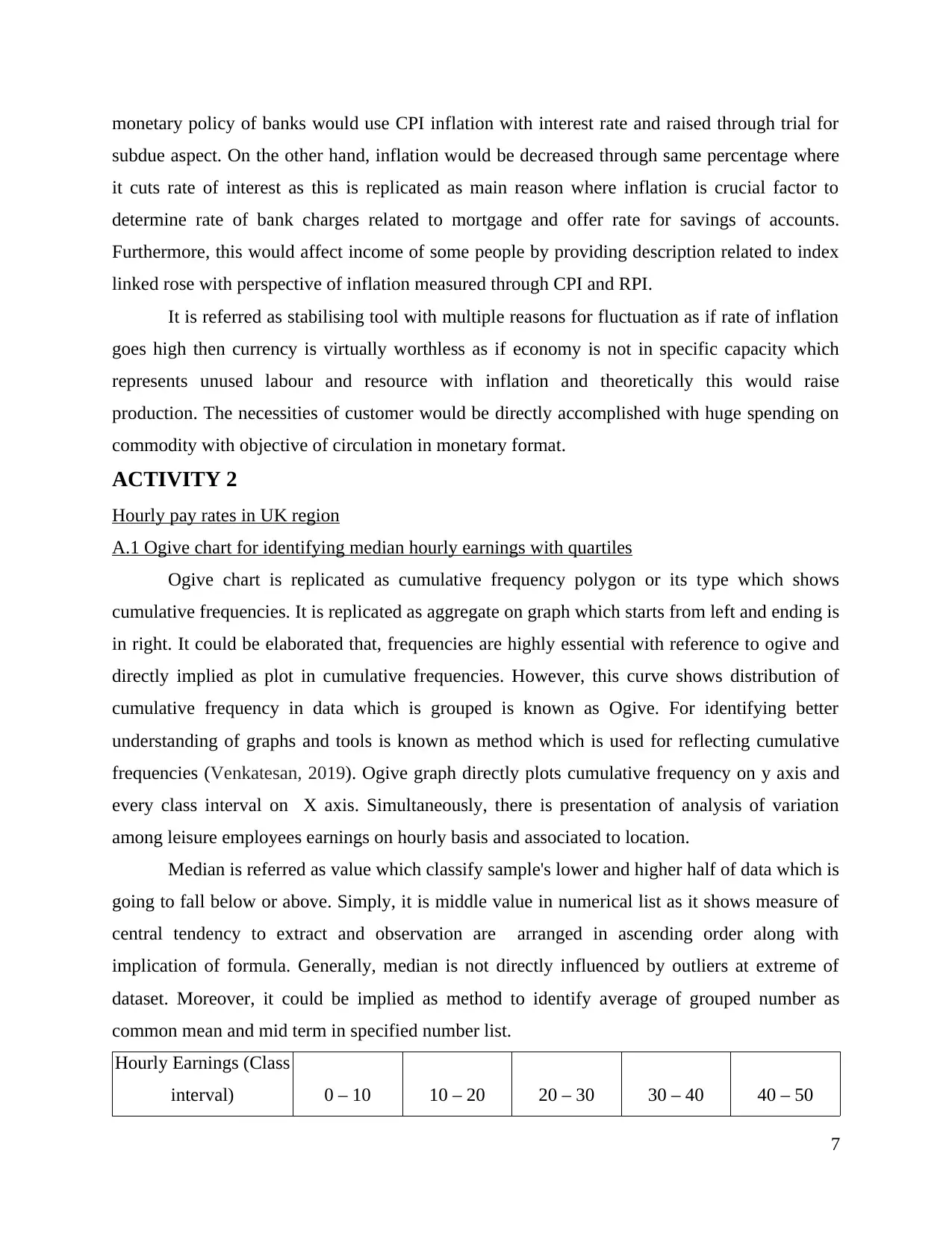
monetary policy of banks would use CPI inflation with interest rate and raised through trial for
subdue aspect. On the other hand, inflation would be decreased through same percentage where
it cuts rate of interest as this is replicated as main reason where inflation is crucial factor to
determine rate of bank charges related to mortgage and offer rate for savings of accounts.
Furthermore, this would affect income of some people by providing description related to index
linked rose with perspective of inflation measured through CPI and RPI.
It is referred as stabilising tool with multiple reasons for fluctuation as if rate of inflation
goes high then currency is virtually worthless as if economy is not in specific capacity which
represents unused labour and resource with inflation and theoretically this would raise
production. The necessities of customer would be directly accomplished with huge spending on
commodity with objective of circulation in monetary format.
ACTIVITY 2
Hourly pay rates in UK region
A.1 Ogive chart for identifying median hourly earnings with quartiles
Ogive chart is replicated as cumulative frequency polygon or its type which shows
cumulative frequencies. It is replicated as aggregate on graph which starts from left and ending is
in right. It could be elaborated that, frequencies are highly essential with reference to ogive and
directly implied as plot in cumulative frequencies. However, this curve shows distribution of
cumulative frequency in data which is grouped is known as Ogive. For identifying better
understanding of graphs and tools is known as method which is used for reflecting cumulative
frequencies (Venkatesan, 2019). Ogive graph directly plots cumulative frequency on y axis and
every class interval on X axis. Simultaneously, there is presentation of analysis of variation
among leisure employees earnings on hourly basis and associated to location.
Median is referred as value which classify sample's lower and higher half of data which is
going to fall below or above. Simply, it is middle value in numerical list as it shows measure of
central tendency to extract and observation are arranged in ascending order along with
implication of formula. Generally, median is not directly influenced by outliers at extreme of
dataset. Moreover, it could be implied as method to identify average of grouped number as
common mean and mid term in specified number list.
Hourly Earnings (Class
interval) 0 – 10 10 – 20 20 – 30 30 – 40 40 – 50
7
subdue aspect. On the other hand, inflation would be decreased through same percentage where
it cuts rate of interest as this is replicated as main reason where inflation is crucial factor to
determine rate of bank charges related to mortgage and offer rate for savings of accounts.
Furthermore, this would affect income of some people by providing description related to index
linked rose with perspective of inflation measured through CPI and RPI.
It is referred as stabilising tool with multiple reasons for fluctuation as if rate of inflation
goes high then currency is virtually worthless as if economy is not in specific capacity which
represents unused labour and resource with inflation and theoretically this would raise
production. The necessities of customer would be directly accomplished with huge spending on
commodity with objective of circulation in monetary format.
ACTIVITY 2
Hourly pay rates in UK region
A.1 Ogive chart for identifying median hourly earnings with quartiles
Ogive chart is replicated as cumulative frequency polygon or its type which shows
cumulative frequencies. It is replicated as aggregate on graph which starts from left and ending is
in right. It could be elaborated that, frequencies are highly essential with reference to ogive and
directly implied as plot in cumulative frequencies. However, this curve shows distribution of
cumulative frequency in data which is grouped is known as Ogive. For identifying better
understanding of graphs and tools is known as method which is used for reflecting cumulative
frequencies (Venkatesan, 2019). Ogive graph directly plots cumulative frequency on y axis and
every class interval on X axis. Simultaneously, there is presentation of analysis of variation
among leisure employees earnings on hourly basis and associated to location.
Median is referred as value which classify sample's lower and higher half of data which is
going to fall below or above. Simply, it is middle value in numerical list as it shows measure of
central tendency to extract and observation are arranged in ascending order along with
implication of formula. Generally, median is not directly influenced by outliers at extreme of
dataset. Moreover, it could be implied as method to identify average of grouped number as
common mean and mid term in specified number list.
Hourly Earnings (Class
interval) 0 – 10 10 – 20 20 – 30 30 – 40 40 – 50
7
⊘ This is a preview!⊘
Do you want full access?
Subscribe today to unlock all pages.

Trusted by 1+ million students worldwide
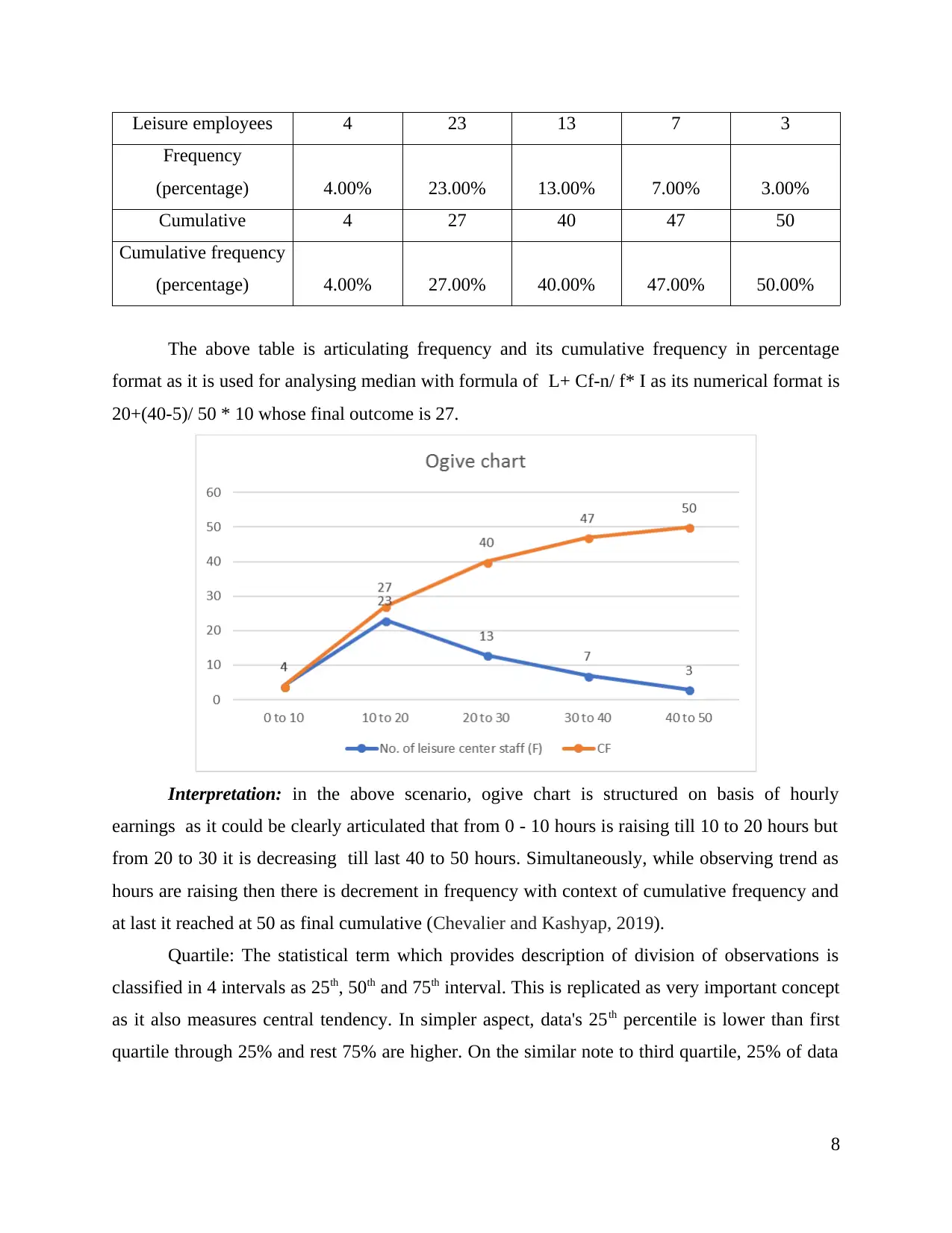
Leisure employees 4 23 13 7 3
Frequency
(percentage) 4.00% 23.00% 13.00% 7.00% 3.00%
Cumulative 4 27 40 47 50
Cumulative frequency
(percentage) 4.00% 27.00% 40.00% 47.00% 50.00%
The above table is articulating frequency and its cumulative frequency in percentage
format as it is used for analysing median with formula of L+ Cf-n/ f* I as its numerical format is
20+(40-5)/ 50 * 10 whose final outcome is 27.
Interpretation: in the above scenario, ogive chart is structured on basis of hourly
earnings as it could be clearly articulated that from 0 - 10 hours is raising till 10 to 20 hours but
from 20 to 30 it is decreasing till last 40 to 50 hours. Simultaneously, while observing trend as
hours are raising then there is decrement in frequency with context of cumulative frequency and
at last it reached at 50 as final cumulative (Chevalier and Kashyap, 2019).
Quartile: The statistical term which provides description of division of observations is
classified in 4 intervals as 25th, 50th and 75th interval. This is replicated as very important concept
as it also measures central tendency. In simpler aspect, data's 25th percentile is lower than first
quartile through 25% and rest 75% are higher. On the similar note to third quartile, 25% of data
8
Frequency
(percentage) 4.00% 23.00% 13.00% 7.00% 3.00%
Cumulative 4 27 40 47 50
Cumulative frequency
(percentage) 4.00% 27.00% 40.00% 47.00% 50.00%
The above table is articulating frequency and its cumulative frequency in percentage
format as it is used for analysing median with formula of L+ Cf-n/ f* I as its numerical format is
20+(40-5)/ 50 * 10 whose final outcome is 27.
Interpretation: in the above scenario, ogive chart is structured on basis of hourly
earnings as it could be clearly articulated that from 0 - 10 hours is raising till 10 to 20 hours but
from 20 to 30 it is decreasing till last 40 to 50 hours. Simultaneously, while observing trend as
hours are raising then there is decrement in frequency with context of cumulative frequency and
at last it reached at 50 as final cumulative (Chevalier and Kashyap, 2019).
Quartile: The statistical term which provides description of division of observations is
classified in 4 intervals as 25th, 50th and 75th interval. This is replicated as very important concept
as it also measures central tendency. In simpler aspect, data's 25th percentile is lower than first
quartile through 25% and rest 75% are higher. On the similar note to third quartile, 25% of data
8
Paraphrase This Document
Need a fresh take? Get an instant paraphrase of this document with our AI Paraphraser
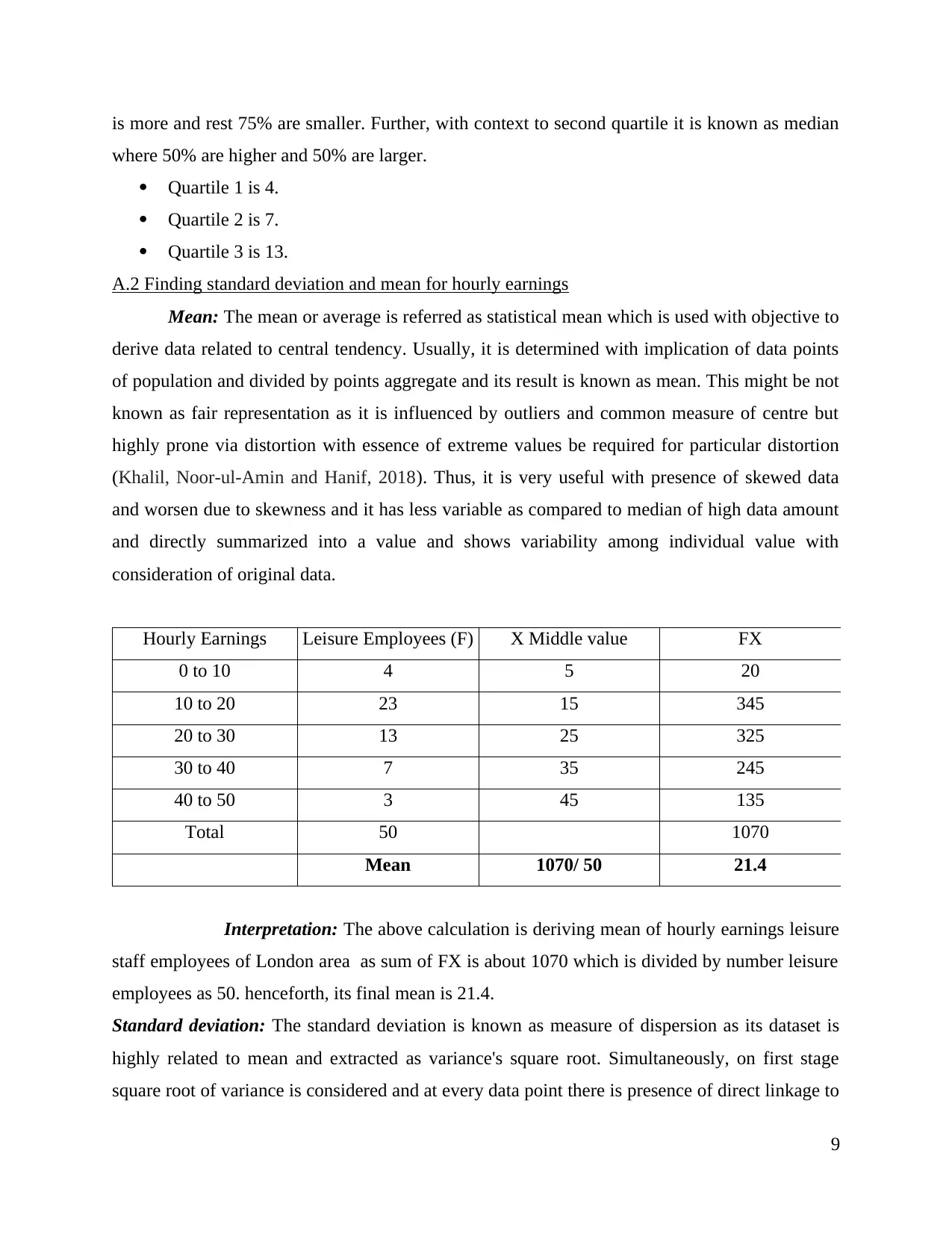
is more and rest 75% are smaller. Further, with context to second quartile it is known as median
where 50% are higher and 50% are larger.
Quartile 1 is 4.
Quartile 2 is 7.
Quartile 3 is 13.
A.2 Finding standard deviation and mean for hourly earnings
Mean: The mean or average is referred as statistical mean which is used with objective to
derive data related to central tendency. Usually, it is determined with implication of data points
of population and divided by points aggregate and its result is known as mean. This might be not
known as fair representation as it is influenced by outliers and common measure of centre but
highly prone via distortion with essence of extreme values be required for particular distortion
(Khalil, Noor-ul-Amin and Hanif, 2018). Thus, it is very useful with presence of skewed data
and worsen due to skewness and it has less variable as compared to median of high data amount
and directly summarized into a value and shows variability among individual value with
consideration of original data.
Hourly Earnings Leisure Employees (F) X Middle value FX
0 to 10 4 5 20
10 to 20 23 15 345
20 to 30 13 25 325
30 to 40 7 35 245
40 to 50 3 45 135
Total 50 1070
Mean 1070/ 50 21.4
Interpretation: The above calculation is deriving mean of hourly earnings leisure
staff employees of London area as sum of FX is about 1070 which is divided by number leisure
employees as 50. henceforth, its final mean is 21.4.
Standard deviation: The standard deviation is known as measure of dispersion as its dataset is
highly related to mean and extracted as variance's square root. Simultaneously, on first stage
square root of variance is considered and at every data point there is presence of direct linkage to
9
where 50% are higher and 50% are larger.
Quartile 1 is 4.
Quartile 2 is 7.
Quartile 3 is 13.
A.2 Finding standard deviation and mean for hourly earnings
Mean: The mean or average is referred as statistical mean which is used with objective to
derive data related to central tendency. Usually, it is determined with implication of data points
of population and divided by points aggregate and its result is known as mean. This might be not
known as fair representation as it is influenced by outliers and common measure of centre but
highly prone via distortion with essence of extreme values be required for particular distortion
(Khalil, Noor-ul-Amin and Hanif, 2018). Thus, it is very useful with presence of skewed data
and worsen due to skewness and it has less variable as compared to median of high data amount
and directly summarized into a value and shows variability among individual value with
consideration of original data.
Hourly Earnings Leisure Employees (F) X Middle value FX
0 to 10 4 5 20
10 to 20 23 15 345
20 to 30 13 25 325
30 to 40 7 35 245
40 to 50 3 45 135
Total 50 1070
Mean 1070/ 50 21.4
Interpretation: The above calculation is deriving mean of hourly earnings leisure
staff employees of London area as sum of FX is about 1070 which is divided by number leisure
employees as 50. henceforth, its final mean is 21.4.
Standard deviation: The standard deviation is known as measure of dispersion as its dataset is
highly related to mean and extracted as variance's square root. Simultaneously, on first stage
square root of variance is considered and at every data point there is presence of direct linkage to
9
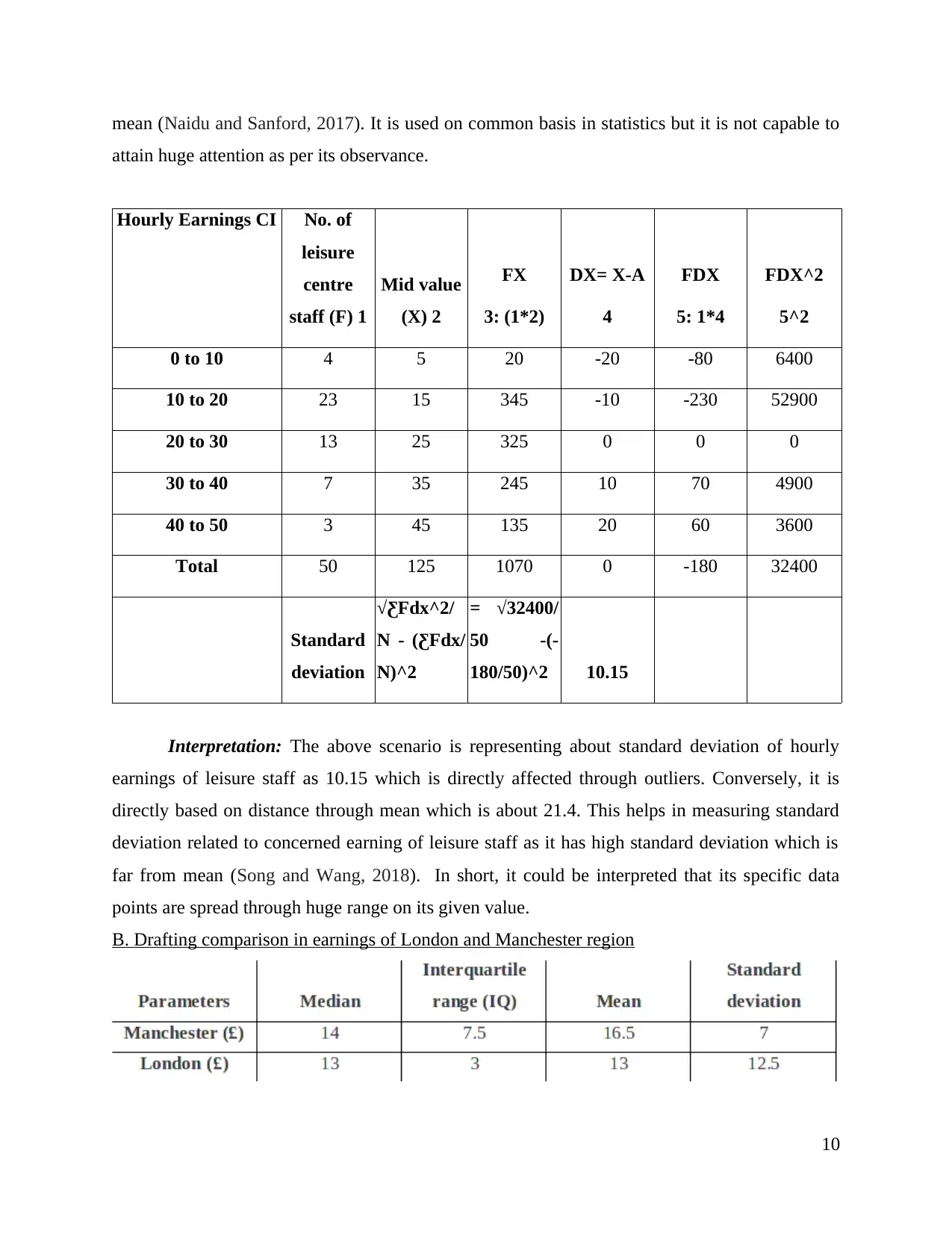
mean (Naidu and Sanford, 2017). It is used on common basis in statistics but it is not capable to
attain huge attention as per its observance.
Hourly Earnings CI No. of
leisure
centre
staff (F) 1
Mid value
(X) 2
FX
3: (1*2)
DX= X-A
4
FDX
5: 1*4
FDX^2
5^2
0 to 10 4 5 20 -20 -80 6400
10 to 20 23 15 345 -10 -230 52900
20 to 30 13 25 325 0 0 0
30 to 40 7 35 245 10 70 4900
40 to 50 3 45 135 20 60 3600
Total 50 125 1070 0 -180 32400
Standard
deviation
√ƸFdx^2/
N - (ƸFdx/
N)^2
= √32400/
50 -(-
180/50)^2 10.15
Interpretation: The above scenario is representing about standard deviation of hourly
earnings of leisure staff as 10.15 which is directly affected through outliers. Conversely, it is
directly based on distance through mean which is about 21.4. This helps in measuring standard
deviation related to concerned earning of leisure staff as it has high standard deviation which is
far from mean (Song and Wang, 2018). In short, it could be interpreted that its specific data
points are spread through huge range on its given value.
B. Drafting comparison in earnings of London and Manchester region
10
attain huge attention as per its observance.
Hourly Earnings CI No. of
leisure
centre
staff (F) 1
Mid value
(X) 2
FX
3: (1*2)
DX= X-A
4
FDX
5: 1*4
FDX^2
5^2
0 to 10 4 5 20 -20 -80 6400
10 to 20 23 15 345 -10 -230 52900
20 to 30 13 25 325 0 0 0
30 to 40 7 35 245 10 70 4900
40 to 50 3 45 135 20 60 3600
Total 50 125 1070 0 -180 32400
Standard
deviation
√ƸFdx^2/
N - (ƸFdx/
N)^2
= √32400/
50 -(-
180/50)^2 10.15
Interpretation: The above scenario is representing about standard deviation of hourly
earnings of leisure staff as 10.15 which is directly affected through outliers. Conversely, it is
directly based on distance through mean which is about 21.4. This helps in measuring standard
deviation related to concerned earning of leisure staff as it has high standard deviation which is
far from mean (Song and Wang, 2018). In short, it could be interpreted that its specific data
points are spread through huge range on its given value.
B. Drafting comparison in earnings of London and Manchester region
10
⊘ This is a preview!⊘
Do you want full access?
Subscribe today to unlock all pages.

Trusted by 1+ million students worldwide
1 out of 20
Related Documents
Your All-in-One AI-Powered Toolkit for Academic Success.
+13062052269
info@desklib.com
Available 24*7 on WhatsApp / Email
![[object Object]](/_next/static/media/star-bottom.7253800d.svg)
Unlock your academic potential
Copyright © 2020–2025 A2Z Services. All Rights Reserved. Developed and managed by ZUCOL.





